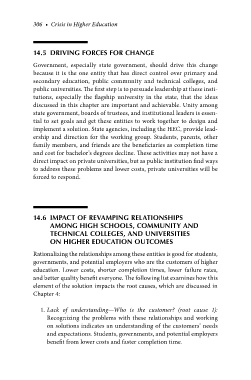Page 336 - Crisis in Higher Education
P. 336
306 • Crisis in Higher Education
14.5 DRIVING FORCES FOR CHANGE
Government, especially state government, should drive this change
because it is the one entity that has direct control over primary and
secondary education, public community and technical colleges, and
public universities. The first step is to persuade leadership at these insti-
tutions, especially the flagship university in the state, that the ideas
discussed in this chapter are important and achievable. Unity among
state government, boards of trustees, and institutional leaders is essen-
tial to set goals and get these entities to work together to design and
implement a solution. State agencies, including the HEC, provide lead-
ership and direction for the working group. Students, parents, other
family members, and friends are the beneficiaries as completion time
and cost for bachelor’s degrees decline. These activities may not have a
direct impact on private universities, but as public institution find ways
to address these problems and lower costs, private universities will be
forced to respond.
14.6 IMPACT OF REVAMPING RELATIONSHIPS
AMONG HIGH SCHOOLS, COMMUNITY AND
TECHNICAL COLLEGES, AND UNIVERSITIES
ON HIGHER EDUCATION OUTCOMES
Rationalizing the relationships among these entities is good for students,
governments, and potential employers who are the customers of higher
education. Lower costs, shorter completion times, lower failure rates,
and better quality benefit everyone. The following list examines how this
element of the solution impacts the root causes, which are discussed in
Chapter 4:
1. Lack of understanding—Who is the customer? (root cause 1):
Recognizing the problems with these relationships and working
on solutions indicates an understanding of the customers’ needs
and expectations. Students, governments, and potential employers
benefit from lower costs and faster completion time.

